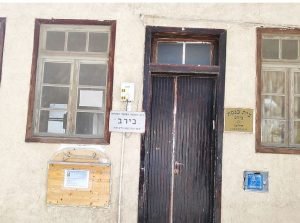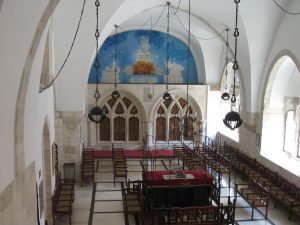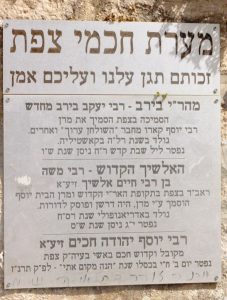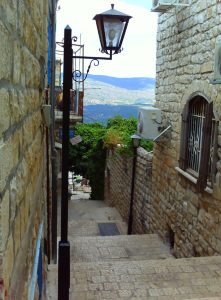The heroic act of semicha performed by Rabbi Yehuda ben Bava (see here) during the Roman persecutions of the second century CE is well known. The tale is related in Sanhedrin:
“What did Rabbi Yehuda ben Bava do? He went and sat between two large mountains, between two large cities, and between two Shabbat boundaries: Between Usha and Shefaram, and there he ordained five elders. And they were: Rabbi Meir, and Rabbi Yehuda, and Rabbi Shimon, and Rabbi Yosei, and Rabbi Elazar ben Shammua.” (Sanhedrin 14a)
By giving ordination to five outstanding scholars, Rabbi Yehuda ensured that the chain of tradition would not be broken and that the Oral Law would continue even after the tragic ending of the Bar Kokhba Revolt. But what if semicha really did end? What then?
This is not a hypothetical question. With the abolishment of the patriarchate and the Sanhedrin in the Land of Israel in the fifth century CE, semicha as the Gemara explains it really does end. Students still studied and teachers still taught and cases were still adjudicated but official ordination ceased. This had practical implications but as Jews gradually lost their autonomy during the Middle Ages that became irrelevant.
But we do have a fascinating case of an attempt to revive official semicha in the hope that then the Sanhedrin could be revived. The setting is Tzfat in the sixteenth century, an extraordinary time and place. The small city is populated with luminaries, Kabbalistic and legal geniuses like Rabbi Joseph Karo, Rabbi Isaac Luria (the ARI), Rabbi Shlomo Alsheich and more. Most of its people are there, directly or indirectly, because of one of the most traumatic events in Jewish history, the Spanish expulsion. The tragedy of the Inquisition, forced conversions and ultimately expulsion created a unique historical moment. The Jews of Tzfat (as well as of many other places) felt that they were living in the time just preceding the messianic redemption.
Sixteenth-century Tzfat was a town filled with men and women who would wake up in the middle of the night to pray for the Messiah, who formed all sorts of charitable organizations and who had visions of a utopian future. It was the place where the ARI, the holy Rabbi Isaac Luria, would formulate a new idea of Jewish mysticism that would ignite the Jewish world for the next two centuries. And it was the home of semicha revolutionary Rabbi Yaakov Berab.
Rabbi Yaakov Berab (1475 – 1546) was part of the Spanish story. He was born in Spain and studied there until the expulsion, when he left for North Africa. After becoming the chief rabbi in Fez, Morocco he continued on to the Land of Israel and ended up in Tzfat as a wealthy businessman and a scholar. His students included Rabbi Yosef Karo (the author of the Shulhan Arukh) and Rabbi Moshe di Trani (the Mabit).

Tzfat synagogue named for Rabbi Yaakov Berab
Eliya339 Wikipedia Commons
In 1538, amidst the general Messianic atmosphere. Rabbi Yaakov suggested renewing semicha and reestablishing the Sanhedrin. His rationale came from the verse ציון במשפט תפדה Zion will be redeemed through justice (Isaiah 1:27). Only by giving the proper punishments to those returned Jews who had been forcibly converted, could the Messiah come. His halachic rationale for reestablishing semicha was this passage in Maimonides’ commentary to the Mishnah (although a parallel passage in the Mishnah Torah is more equivocating):
“And it seems to me that when all the scholars and students agree to place one of their number as their head (and if this is in the Land of Israel), that man will have semicha and can give semicha to others” (Maimonides commentary to Mishnah Sanhedrin 1:3)
After Rabbi Yaakov received semicha himself from the rabbis in Tzfat, he decided that he could not carry out this major upheaval without consulting the main authority in Jerusalem, Tzfat’s rival for halachic supremacy. He sent a message to Rabbi Levi ibn Habib (1480 – 1541), head of the Jerusalem community. Rabbi Levi’s life had a similar trajectory to Rabbi Yaakov. He too was born in Spain and with the expulsion his family fled to Portugal and then to Salonika, another major waystation for Spanish Jews. His father was the illustrious Rabbi Yaakov ibn Habib, author of the Ein Yaakov. Rabbi Levi eventually settled in Jerusalem in 1525 and became the Jewish community’s leader. He was responsible for increasing Jerusalem’s importance and indeed saw himself as a servant of the city. His signature says it all:
יושב ירושלים נאנח בשברון מתנייםכי יראה חרבת בית מקדשה סביב
צעיר הלומדים החונים לפני המשכן סביב
“A Jerusalem dweller, sighing with heartbreak over the destroyed Temple, youngest of the students sitting around the Tabernacle”

Rabban Yochanan Ben Zakkai synagogue in Jerusalem
Daniel Ventura, CC BY-SA 4.0 <https://creativecommons.org/licenses/by-sa/4.0>, via Wikimedia Commons
Rabbi Levi was sympathetic to Rabbi Yaakov’s proposal but had hesitations about its halakhic viability. After studying the issue for two weeks, he sent back a negative answer. Rabbi Yaakov was undeterred and gave semicha to four students, among them Karo and di Trani. Then things got out of control. Rabbi Levi published a tract against the semicha. Rabbi Yaakov responded with ad hominem attacks. The controversy was heated, with Jerusalem and Tzfat at each other’s throats.

Burial cave of Rabbi Yaakov Berab in Tzfat
אריאל פלמון Ariel Palmon
And then. . . it was all over. Both principal characters died not long after and the controversy died down. The students who had received semicha passed it on to others but did not do anything as audacious as reconvening the Sanhedrin. Perhaps the best example of how the exercise petered out is this quote in Karo’s work:
“A rapist is sentenced by three judges, if the judges have been given semicha in Eretz Yisrael. And today, when we have no one with semicha, we excommunicate him until he makes restitution. . .” (Shulchan Aruch Even HaEzer 177:2)
Karo himself, who had received Berab’s semicha, says there is no one with semicha today!
So what happened – why did Rabbi Yaakov’s bold initiative fail? Some scholars blame the debacle on a personality clash between Berab and Ibn Habib. Others blame it on the “personalities” and rivalries of Israel’s two main Jewish centers at the time, Tzfat and Jerusalem. While these were probably factors, the deeper clash was between world views and outlooks on halakha. While Berab believed that halakha could be proactive, changing reality to bring the redemption, Ibn Habib was more conservative. He felt one should serve God through the proper following of the law and He will bring the redemption in His own time. Echoes of these approaches can be heard throughout Jewish history, up to and including modern times.

Tzfat
רות סנדמן, CC BY 2.5 <https://creativecommons.org/licenses/by/2.5>, via Wikimedia Commons
Who was right? Even time cannot tell us the answer.










